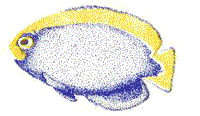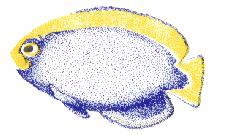|
GROUPERS AND THEIR KIN
By Jim Wolf, Marine Biologist
True groupers are members of the family Serranidae and all are
typical lie in wait predators. They lay motionless waiting for prey to
come near and quickly lunge out at their prey and inhale them with their
voluminous mouths.
They are as a group very hardy and range from the 900 pound Potato Cod
to the 2 inch Royal Gramma. All are usually harmless unless they can eat
their cohorts, and most enjoy a diet of whole fish, shrimp, squid etc.
These fish can change their sex as they age are many are hermaphroditic
(this means they possess both male and female reproductive organs)! Most
are very hardy, but there are some aspects of your particular pet you will
want to consider.
FAMILY SERRANIDAE: The largest group that includes over 400 species.
They are among the most hardiest, and are not as territorial as some of
their smaller relatives. Most do well when fed every 2-3 days, with the
notable exception of the Anthias. These groupers enjoy daily feeding of
plankton, and do best in small schools of 4 or more. Many of them
will grow rapidly so they need an aquarium of at least 60 gallons in size.
At first they may be skittish and shy, but over time they will appear more
often and eat almost anything offered.
FAMILY PSEUDOCHROMIDAE: These dwarf groupers go by the name of
Pseudochromis, Dotty Backs and other descriptive names. Their care
is similar to their larger cousins. They are less tolerant of other fishes,
and can get a bit aggressive. Make sure the aquarium lid is well sealed
as they can jump. The Dotty Back reaches a maximum length of 4 inches.
FAMILY GRAMMIDAE. There are about 10 species of Grammas or Fairly
Basslets in the world but only the Royal Gramma is commonly seen. They
are naturally seen in small schools but do best by themselves in captivity.
At first they are very highly strung so acclimate them carefully. It is
best to dim the light and to feed the other tank mates so that the Gramma
coming out of the bag will not be greeted by hungry or nippy tank mates.
Seal the aquarium lid and provide a small cave for territory and they adapt
readily.
FAMILY PLESIOPIDAE. This is the rare Comet Fish or Marine Betta.
Personally one of my favorite fishes, as it is full of interesting behavior.
During the day it hides in caves with only its tail sticking out. The false
eye spot is thought to help the fish resemble a Moray Eel's head and thus
discourage predators. It also uses its false eye by wrapping its tail near
its head. Confused prey swim away from the false eye into the Betta's mouth!
These animals are very reclusive and not very competitive. They need a
tranquil well established aquarium, and do well on twice weekly feeding
of live guppies or glass shrimp. Their high price is well worth the additional
fascination and surprises that this species holds in store for you!
|











